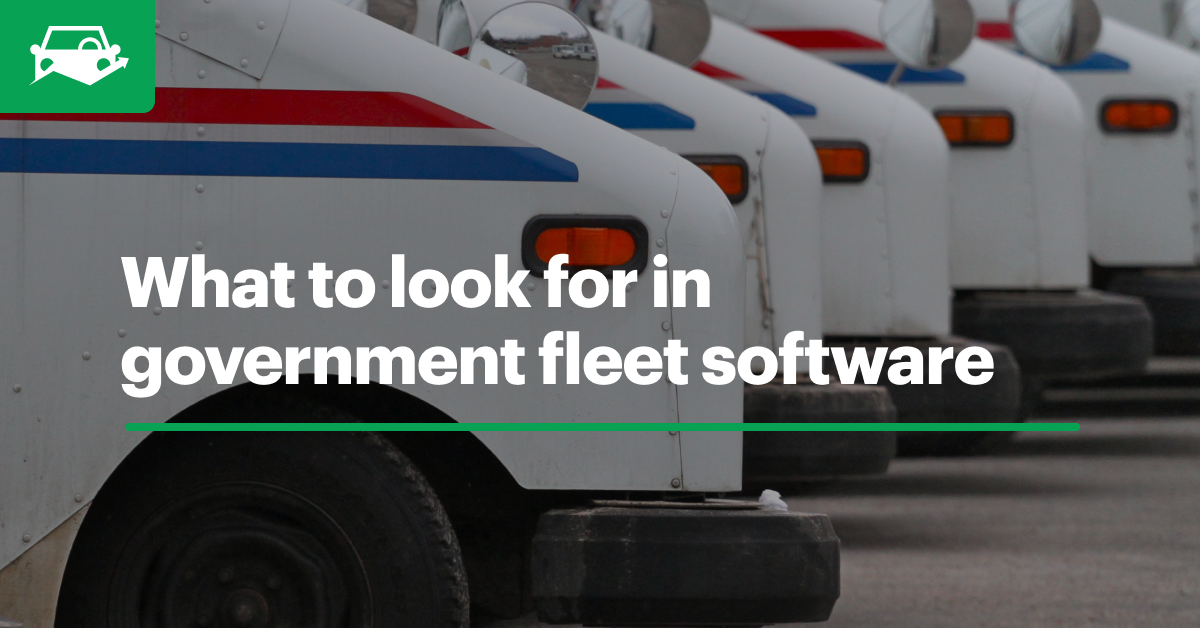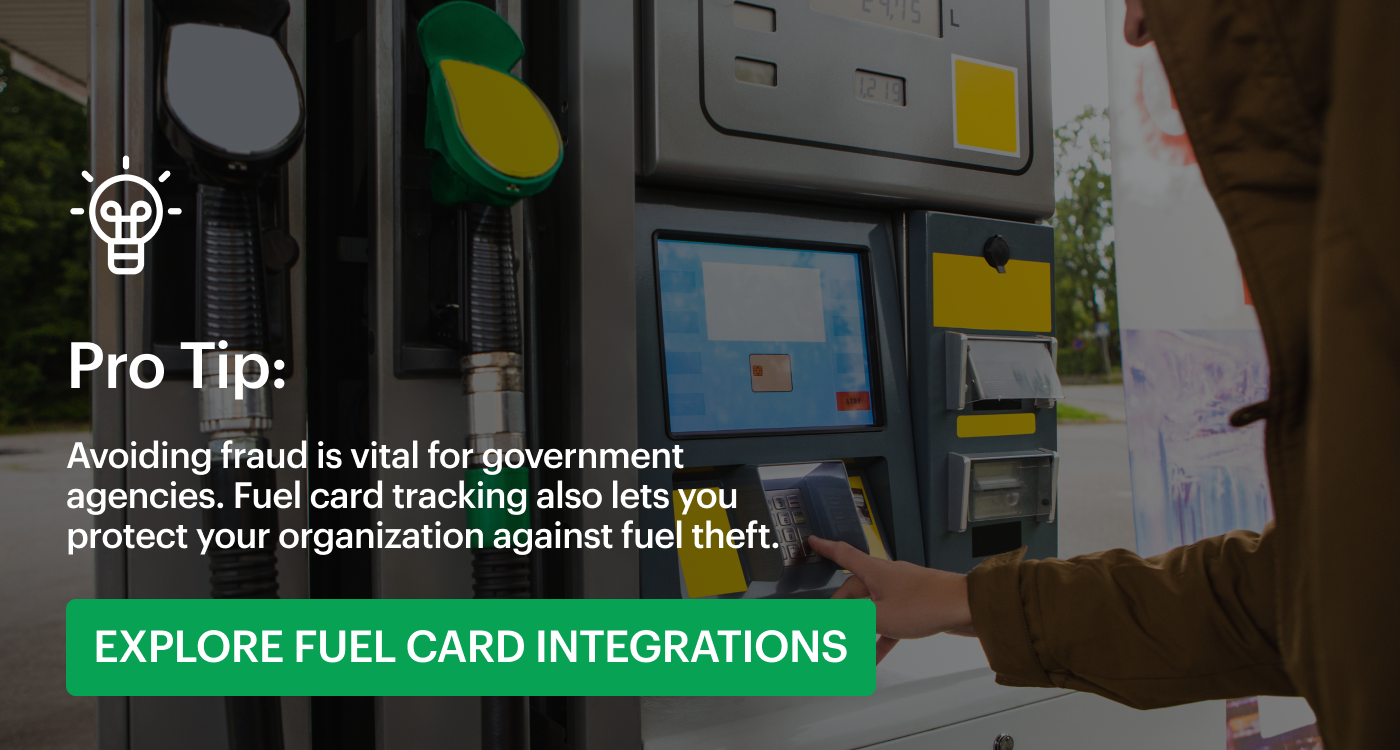Looking for a fleet management system designed to fit your government fleet’s needs? There’s a couple of things you need to determine before you start shopping around.

What makes a good fleet management system can look different for each company, depending on their operational pain points and IT specifications. For government fleets, those needs can be amplified, and checking off each box in your software hunt can be difficult.
Working in the public sector means working within tight budgeting, observing fleet regulations and keeping a close eye on emissions, among other things. And while those are issues all fleets should maintain an awareness of, it’s especially important for governments and municipalities to stay vigilant in their tracking and analysis of fleet operations.
The best way to stay on top of all of the moving parts of running a government fleet is to have a digital fleet management system that grants you consistent and accurate insight into your vehicles and drivers. A good fleet management system allows fleet managers to create simplified processes and automations that enable efficiency that paper and spreadsheets alone can’t accomplish.
So how do you go about finding the right government fleet management software? There are a few questions you should ask before you start scheduling demos.
1. What inefficiencies exist in your current system?
A fleet management system should first and foremost improve upon what you’re already doing, so figuring out where your system is lacking is the first step to augmenting your processes. Do a quick audit of all of the tasks that your fleet requires to stay up and running on a day to day basis and the average amount of time and steps it takes to complete each task to identify where you can begin to streamline.
Some of the biggest areas with room for improvement in most fleets are preventive maintenance (PM) and inspections. This is especially true for government fleets, because buying new vehicles can be a huge expense, sometimes prohibitively within a municipal or state budget, so maintaining vehicles regularly and detecting issues through inspections is vital to extending vehicle life spans.
If your fleet’s PM schedules aren’t optimized to each vehicle and their corresponding warranties, you could be sacrificing years of assets’ usability and inviting more unnecessary, costly breakdowns. Fleet management software enables you to attach maintenance schedules and automated reminders to every vehicle, minimizing downtime with predictability.
Inspections can be a huge timesuck if they’re still being managed with paper forms, and based on the type of fleet vehicles you’re managing, they can present a massive liability for fines if you or your drivers struggle to keep up with them. Using electronic driver vehicle inspection reports (eDVIRs) in a fleet management system gives you access to completed reports from your smartphone or tablet when needed, and allows your drivers to fill out inspections faster and more accurately.
Handling both of these processes digitally also speeds up your response time to incidents and keeps you more aware of what’s going on in your fleet. For example, if an inspection comes through with an issue indicated, you’ll be notified automatically based on the response on the eDVIR, putting you in touch with in-house technicians or outsourced maintenance faster and resolving the issue more quickly, which ultimately equates to less downtime.
Once you start to see where your inefficiencies are, it becomes a lot easier to start narrowing down what you need from a government fleet management software.
2. What integrations do you want?
One of the big strengths of fleet management software is its ability to leverage the data coming from other software you might be using to manage individual facets of fleet management. When you can combine the power of each service together in a central location, you open up a whole new realm of information to use to benefit your government fleet.
A great example of ways integrations can help government fleets in particular is the ability to track fuel expenditures relative to other vehicle data, like total cost of ownership (TCO). Integrating your fuel card provider into your fleet management software gives you immediate insight into fuel expenditures as it relates to the fleet as a whole, not just the monetary amount by itself, and can help you determine TCO on each of your vehicles in real time.

You can also integrate with GPS and telematics providers, which gives you a better understanding of driver behavior and asset utilization. You can get odometer readings right in your fleet management software, as will get notified of any diagnostic trouble codes (DTC) and engine fault alerts without needing updates directly from drivers.
3. What do you need in order to stay compliant?
Whether your fleet is run at the federal, state or local level, you have certain compliance standards to adhere to. It’s of the utmost importance to make sure the fleet management software you choose gives you the resources you need to stay compliant.
For example, if you’re subject to environmental compliance standards, you need a solution that enables you to track vehicle emissions. If you choose a software that has the ability to integrate with telematics devices, you can pay attention to idle times and driver behaviors that might be impacting your fleet’s environmental performance.
When it comes time for internal audits conducted by your organization’s level of governance, having well-maintained records of service and inspections can be a huge boon in representing your fleet’s commitment to standards. Fleet management software makes it easy to keep and reference past service records and eDVIRs, making audits a much faster and more painless process for everyone involved.
Running a fleet at the government level means being responsible for what are ultimately public assets, and you’ll want to be sure you have the reporting capabilities to prove that you’re making good use of government resources. Be sure that the fleet management software you choose has robust reporting capabilities that allow stakeholders visibility into your fleet whenever needed.
4. What are your security needs?
Where there is government data, there are always going to be security concerns. Finding a government fleet management software that prioritizes security is of the utmost importance to maintaining the integrity of your organization’s information.
A breach in your fleet management software can be an easy gateway into other financial information and government data, whether it allows attackers to access login credentials to other platforms or even just credit card information from fuel cards. And if any of your vehicles have internet connectivity or onboard sensors for optimization, these offer alternative routes for attacker entry into WiFi networks the vehicles might be connected to.
A good fleet management software assures secure sign ins and lets you assign vehicles to specific users that can have controlled levels of access to your account. This allows you to know exactly who is with which vehicle at any given time without overextending their access to your platform, and with the right administrative controls, you can remove a user or compel password changes at any time to reduce data security risks.
Attackers approaches are constantly evolving, and your fleet management software should as well. You’ll want to ask for each provider’s security and privacy overviews and ensure that the software you choose is continuously updated with new versions to protect against any vulnerabilities.
5. What fits your budget?
Budgets can be a sore subject in the government world, so looking for a software solution that addresses your primary issues and doesn’t gouge a huge hole in your budget can be tricky. After all, what’s the point of saving money through efficiency if you have to pay out the nose for the tool that enables efficiency?
When you start shopping for fleet management software, take advantage of demos and free trials to get a feel for the ease of use in each platform, and form relationships with sales reps to get a full picture of what you’ll be getting for what you pay. The best decision is an informed one, and you don’t want to go with the first thing that looks good only to find it doesn’t meet all your needs and isn’t cost-effective.
Ready to make the switch to a new government fleet management software? Start your free trial or request a demo of Fleetio today!




